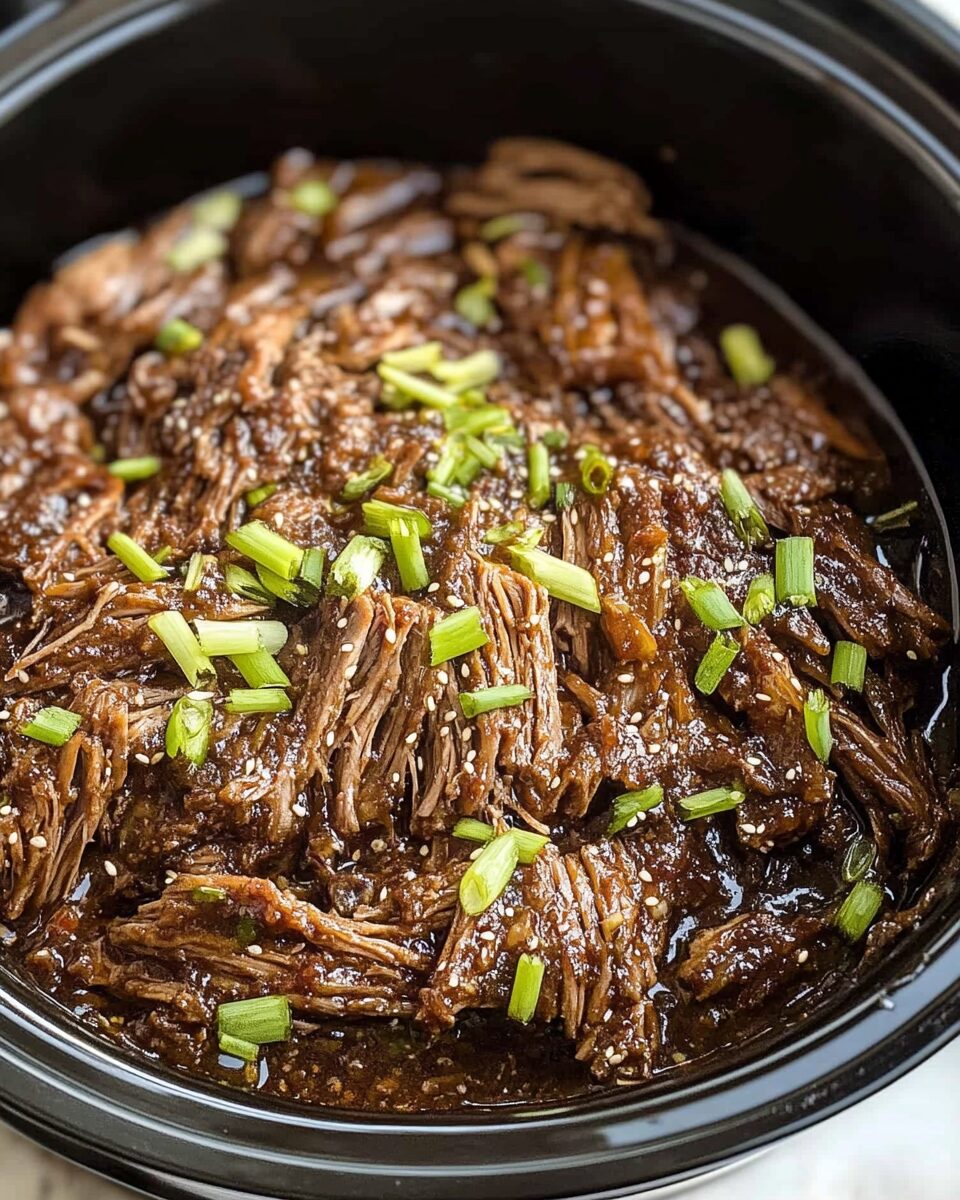Bulgogi, meaning “fire meat” in Korean, is a classic dish featuring thinly sliced beef marinated in a flavorful blend of soy sauce, sugar, sesame oil, garlic, and other ingredients.
FULL RECIPE:
Ingredients
- 1.5 pounds flank steak, thinly sliced
- ½ cup soy sauce
- ½ cup brown sugar
- 2 tablespoons sesame oil
- 4 cloves garlic, minced
- 1 tablespoon freshly grated ginger
- 1 tablespoon rice wine vinegar
- 1 teaspoon red pepper flakes (adjust to taste)
- 1 medium onion, sliced
- 2 green onions, chopped
- 1 tablespoon sesame seeds
- Cooked white rice, for serving
Directions
- Prepare the Marinade: In a bowl, whisk together soy sauce, brown sugar, sesame oil, minced garlic, grated ginger, rice wine vinegar, and red pepper flakes until the sugar dissolves.
- Marinate the Beef: Place the thinly sliced flank steak in a resealable plastic bag or shallow dish. Pour the marinade over the beef, ensuring all pieces are coated. Marinate in the refrigerator for at least 2 hours, preferably overnight, for maximum flavor.
- Slow Cook the Beef: Transfer the marinated beef and sliced onion into a slow cooker. Cook on low heat for 6-8 hours or on high heat for 3-4 hours, until the beef is tender.
- Serve: Garnish the cooked beef with chopped green onions and sesame seeds. Serve hot over cooked white rice.
Nutrition Facts
- Calories: Approximately 436 kcal
- Protein: 36 g
- Carbohydrates: 38 g
- Sugars: 20 g
- Fat: 15 g
- Saturated Fat: 5 g
- Cholesterol: 95 mg
- Sodium: 1,200 mg
- Fiber: 1 g
What Makes Bulgogi Special?
Bulgogi stands out for its perfect balance of flavors—sweet, savory, garlicky, and smoky. The use of fresh pear or apple in the marinade helps break down the meat’s fibers, resulting in a tender and juicy texture. Unlike other grilled beef dishes, bulgogi is often cooked with onions, carrots, and mushrooms, adding extra layers of flavor and texture. Whether cooked on a charcoal grill, stovetop, or cast-iron skillet, bulgogi is a crowd-pleaser that delivers deep umami flavors in every bite.
The Origins and History of Bulgogi
Bulgogi has a long history dating back to the Goguryeo Dynasty (37 BCE – 668 CE), where it was originally called maekjeok—skewered and grilled meat. Over time, it evolved into neobiani, a delicacy enjoyed by Korean royalty during the Joseon Dynasty, where beef was sliced thin and marinated before grilling. The modern-day version of bulgogi became widely popular in the 20th century, especially with the introduction of Korean BBQ restaurants worldwide. Today, bulgogi remains an essential part of Korean cuisine, enjoyed in home-cooked meals, celebrations, and social gatherings.
The Cultural Significance of Bulgogi
Bulgogi has deep roots in Korean tradition, dating back to the Goguryeo era over a thousand years ago. Originally known as “maekjeok,” it was skewered and grilled, evolving over centuries into the dish we recognize today. It holds a prominent place in Korean celebrations and family gatherings, often served as a main dish during special occasions. Korean BBQ restaurants worldwide have popularized Bulgogi, offering diners the experience of cooking the meat at their table using built-in grills. Sharing Bulgogi with loved ones creates a communal dining experience, reflecting the warmth and hospitality of Korean culture.
Versatility and Serving Options
One of the appealing aspects of Bulgogi is its versatility. While beef is the most common protein choice, variations using pork or chicken are also popular. The dish can be customized by incorporating additional vegetables like mushrooms, carrots, or bell peppers, enhancing both its flavor and visual appeal. It is traditionally served with steamed white rice and a variety of side dishes known as “banchan,” which may include kimchi, pickled vegetables, and seasoned greens. For a low-carb option, Bulgogi can be wrapped in fresh lettuce leaves, often accompanied by spicy sauces and garlic cloves for added zest.
Health Benefits and Nutritional Insights
Bulgogi offers a balanced mix of protein, carbohydrates, and fats, making it a satisfying and nutrient-rich meal. Lean cuts of beef are often used, providing a good source of protein and essential vitamins like B12 and iron. The garlic and ginger in the marinade offer anti-inflammatory properties and can aid in digestion. However, the dish’s sodium and sugar content should be considered, especially for individuals managing their intake. By moderating portion sizes and pairing it with fiber-rich vegetables, Bulgogi can be enjoyed as part of a well-rounded diet.
Serving and Storage Tips
Bulgogi tastes best freshly cooked, but leftovers can be stored in an airtight container in the refrigerator for up to 3 days. Reheating on a stovetop maintains its texture better than microwaving. Bulgogi can also be frozen in its marinade for up to one month, making it a great make-ahead meal option.
Cooking Methods and Tips
Although traditional Bulgogi is prepared using a grill, it can also be cooked using a stovetop skillet, cast iron pan, or even in a slow cooker for added convenience. Each method brings out different textures and flavors in the meat. Marinating the beef for several hours or overnight allows the flavors to fully penetrate, resulting in a tender and flavorful bite. Additionally, thinly slicing the beef against the grain ensures the meat remains tender and easy to chew. For a smoky, authentic flavor, grilling over charcoal is highly recommended.
Why You Should Try This Recipe
Korean BBQ Beef is a perfect dish to explore for those who enjoy bold flavors and cultural culinary experiences. Its blend of savory and sweet notes, combined with the aromatic sesame and garlic, creates a memorable taste. The preparation process is straightforward, making it accessible even for beginners. Additionally, its adaptability means you can customize the marinade or side dishes to suit your preferences. Hosting a Korean BBQ night at home can be a fun and interactive way to share a delicious meal with family and friends.
Conclusion
Bulgogi stands as a shining example of Korea’s rich culinary heritage, celebrated for its irresistible flavor and cultural significance. Whether prepared for a festive gathering or a simple family dinner, it delivers a comforting and satisfying experience. By experimenting with different ingredients and cooking techniques, you can make this traditional dish uniquely your own. Embracing the essence of Korean BBQ Beef is not only a culinary journey but also an opportunity to connect with the heart of Korean cuisine.





